2.3: Cave Art
- Last updated
- Save as PDF
- Page ID
- 56229
Cave Art
Cave artists invented the art methods and materials we still use today. Although some of the products have been streamlined and placed in paint tubes or formed into sticks, the material to form paint still requires a binder and powdered or ground minerals. The indigenous artists used charcoal from the fire pit to outline an animal on the wall and filled the lines with earthen pigments. Some of the artists incised the rock to make a permanent line, then added pigment to embellish the work.
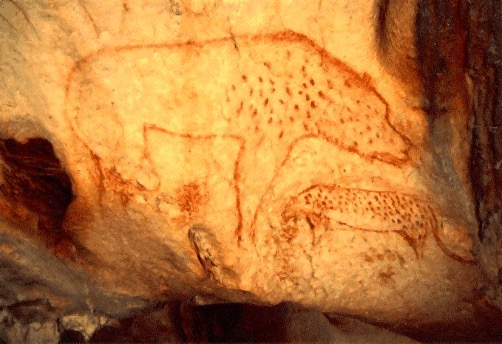
The first paintings in caves were line drawings (2.8) made of dark charcoal, a byproduct from burning wood, and used to draw primitive symbols. The indigenous people had access to plenty of charcoal, regardless of where they lived in the world, using wood for the fire was their primary cooking source and how they kept warm. To color the animals on the walls, as they became more experienced, they used additional natural elements found abundantly on the ground or in rocks,
The colors used in the caves are classified as earth tone colors because the artists created their paint from the earth. The prehistoric people started the use of color, and it endures today. The indigenous people probably did not know the color wheel. They mixed the colors they had to obtain secondary colors. Mixing colors with black, white, or grey creates different hues of the original base color. All color has three different properties called hue, value, and intensity, and when artists add black or white to prime colors, the properties are changed. When white is mixed into red ochre to lighten the original color, the value or tint of the original color becomes lightened, mixing black with red ochre darkens the value or shade of the original color. When a color has is mixed with grey, the tone of the color is changed. Mixing red ochre with some black gives the new color some depth and perhaps even made the cave paintings look more realistic in the soft glow of a fire.
Clay-like rocks contain mineral-based oxides, providing a variety of colors; for example, rocks with iron oxide produced a reddish-brown color, and the indigenous artist could form this clay into sticks of “paint” similar to a pastel crayon. The rocks could also be ground into a powder and mixed with a binder. The different colors of “paint” depended on the raw materials they had on hand. The earlier paintings were created with found rocks containing minerals of kaolin, manganese, or iron oxide in primary colors: black, brown, white, yellow, and various shades of red.
Different pigments and colors were used in different parts of the world because the rocks and soil in each area had a slightly different composition. In Australia, the palette included charcoal, yellow ochre, and red ochre. The pigments used in Africa were red and orange made from ochres, whites from zinc oxides, black from charcoal, and browns from hematite as well as a blue color from iron unique to Africa. Kaolin for white commonly used in China and a variety of blacks made from manganese oxides used in France. Most of the rock and minerals used in these paintings are from the local environment. In some areas, the rock used in the drawings traveled from faraway places, denoting signs that trails existed. The indigenous cave dwellers also stockpiled the minerals they needed to make future paintings.
The different colors of “paint” would depend on the raw materials they had on hand. Some of the most common colors are:
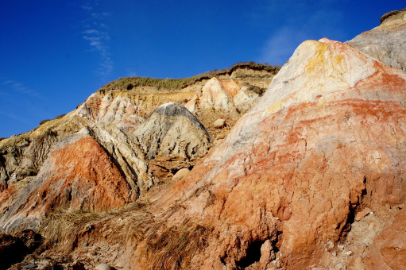
2.9 Red Ochre
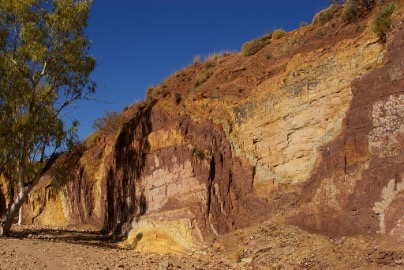
2.10 Yellow ochre
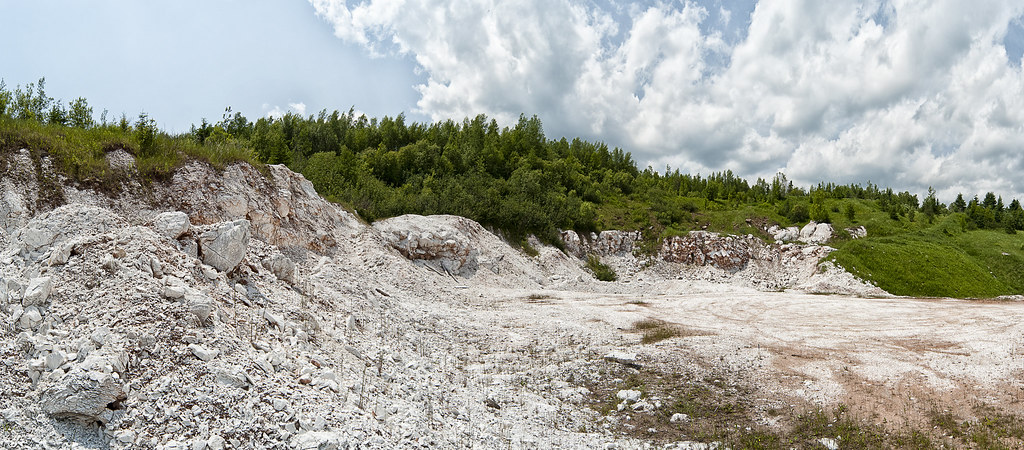
2.11 Lime white rock
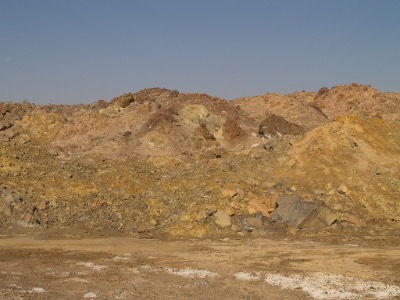
2.12 Umber
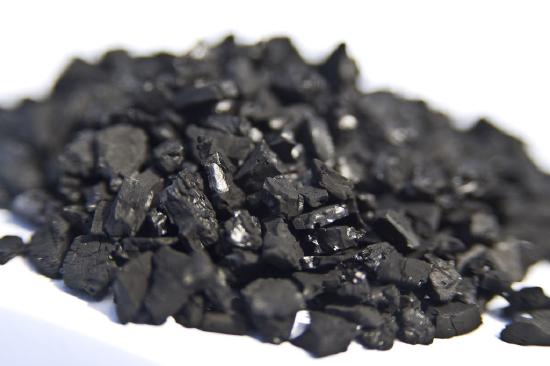
2.13 Black carbon
To create paint, cave dwellers ground the rocks or clay by hand. Many caves have hollows in the rock floor with stains that indicate places people used to make a fine powder from the minerals. To bind the powder into the paint, the artist had several choices of natural binders; animal fat, blood, bone marrow, spit or water, making a paste, and forming it into sticks allowing the paint to be applied directly to the walls. Over time they must have experimented with different types of natural resources to create a paint that would spread, adhere to the wall, and fortunately endured for thousands of years.
Pastels, comprised of finely ground powdered pigment, are mixed with some type of binder. The indigenous people, through experimentation, were technically the first to create pastels, although not given credit. Modern pastels, invented in the 17th century, were manufactured by machines, yielding a standard product. However, the indigenous artists frequently took lumps of the color they mixed or formed into sticks, and drew directly on the wall, as we would today with a pastel crayon.
Chalk is very similar to pastels, but instead of a result of grinding rock into a fine powder, the chalk is in its natural state. Chalk is formed from limestone and about 100 million years ago when it was initially under the sea. Today, chalk is mined from the earth, and the chalk is compacted into cylinder shapes familiar in classrooms today. Many of the drawn cave paintings were with the lumps of chalk they found naturally in their environment.
The cave dwellers were extremely creative in the methods they used to apply the paint to the walls. Historians believe paint was applied by patting on or dabbing it on using fingers, pads of animal skin, or clumps of moss. Sometimes more sophisticated “brushes” were made out of twigs and animal hair or fur to apply the paint. They even made spraying implements out of hollow bones to blow the paint through, similar to a straw or blew paint directly from their mouth. These techniques used to make the stencil-looking handprints found in many caves.
The pattern in art applies to the design of the surface of the art. For example, cave art has similar applications of pattern; they all are drawn or carved on rock surfaces. Some of the caves have more texture or rocky, bumpy surfaces, and some of the caves or rocks are smooth or have slight bumpy surfaces. The most important part about the texture in the caves is the drawing surface had enough texture to capture part of the charcoal or pigment, leaving it in the rock and creating a rough design. The drawing is rough to the touch, and this rough-looking pattern is what makes the cave art unique and sets it apart from another art.
Drawing may have helped the indigenous people make sense of their world and offer a way to communicate with others, and in some caves, the drawings were simplistic, others more complex and sophisticated. A simple drawing is depicted in the Coliboaia Cave in Romania, the red ochre drawings contrast against the whiter walls of the cave, but the figures are not complicated. If the caves had been open and exposed to the elements, instead of sealed off, the artwork would probably have been destroyed or subjected to natural forces like mold, causing them to vanish over time.
African Caves
Blombos Cave – South Africa: The Blombos Cave is located on the southern-most tip of South Africa and dated between 70,000 to 100,000 years old. A variety of art discovered inside these caves range from engraved bones, necklaces of marine shell beads, engraved ochre remains, to over 500 fragments of stone tools. The findings inside the Blombos Cave resulted in a paradigm shift in cultural anthropologists' understanding of human behavior. The carved piece of ochre (2.14) demonstrates a repetitive pattern of parallel incised lines in a thick piece of ochre rock. This type of discovery links a relationship to modern human behavior and demonstrates the complex cognitive development of prehistoric humans.
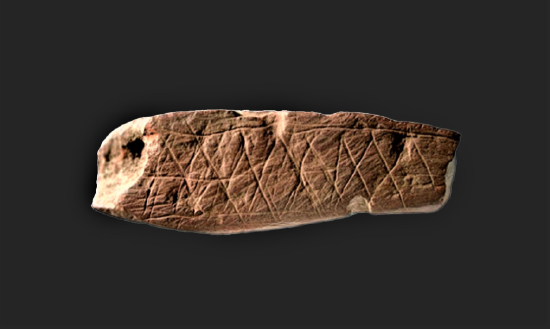
2.14 Carved ochre – Blombos Cave
Apollo II – Namibia: A cave known to natives as Goachanas is located in Namibia, Africa, set up high on a ridge overlooking the Nuob river in the Huns Mountains. It was used for thousands of years by indigenous people and only through British imperialism, was it known to the world. The English name was given to the cave by a British archeologist who was in the cave when he heard the Apollo 11 successfully landed on the moon in 1969. One of the oldest images in the world resides in the Apollo 11 Cave (2.15). The cave is famous for housing one of the oldest pieces of transportable art in the world, a quartzite stone slab drawing of an animal. The “paint” used by the bushman was a combination of ostrich egg yolk and ground ochre. Also discovered was an incised ocher dating to 100,000 BCE, used to draw and paint animals on stone walls. Most of this art was considered mobile art and easily carried from place to place.
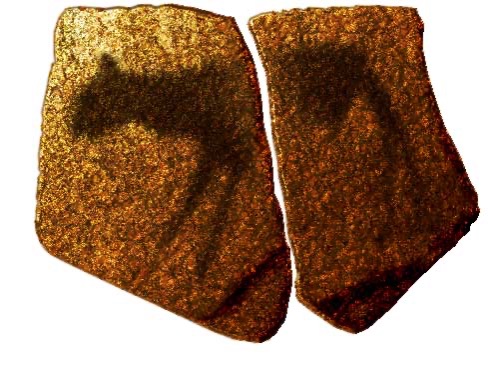
2.15 Stone slab from Apollo 11
Asian Caves
Damaidi – China: The Damaidi Cave contains over 3170 sets of petroglyphs and over 8,000 pieces of art, which historians consider to be a selection of the origin of the Chinese characters used in writing today. Although the drawings are similar to other caves with hunting scenes, the Damaidi Cave also displays a cultural interest in the night sky. The cave located on a bend of the Yellow River was home to nomadic people living in the area. They used the caves and outcrops of rock to record their daily life and the living conditions by etching images into the rock and filling them with pigment. If these carvings are the beginning of the written language, it will push the origins of writing, as we know today.
Bhimbetka – India: The oldest cave art in India located at the Bhimbetka rock shelters dating to 30,000 BCE. Displayed on the walls is the culture of India, with people dancing a cultural tradition lasting through the archeological record. The caves have been used for thousands of years, beginning with representations of animals, later depictions of people and musical instruments to the final period of geometric scenes. The walls and ceilings depict art (2.16) in vibrant and compelling paintings portraying their daily life through 30,000 years — the dark orange paint made from hematite, iron oxide, and kaolin combined with animal fat.
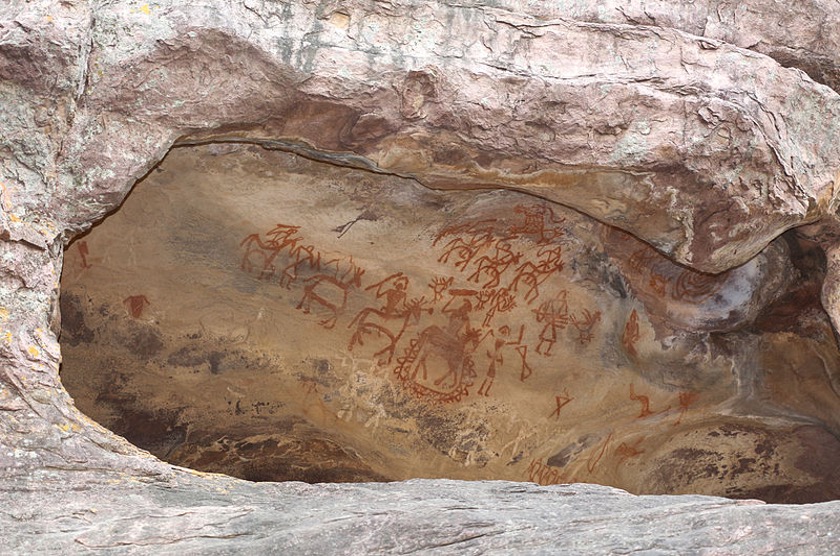
2.16 Paintings in Rock Shelter 8
European Caves
Chauvet – France: In 1994, Jean-Marie Chauvet searched and finally found one of the most important prehistoric caves in the world. The cave was sealed for over 36,000 years and held over 100,000 drawings, providing information and giving us more understanding about the lives of the indigenous people of the region.
“We found ourselves in front of a rock wall covered entirely with red ocher drawings” as they (Chauvet, Brunel and Hillaire) tunneled their way into the Chauvet Cave for the first time, a world frozen in time.
Imagine crawling through a hole no wider than a human body, in pitch-black darkness with only a single source headlamp. The air inside the cave is over 30,000 years old, eyes are trying to adjust to the dim light, and then, finally, your first look, the chalky outline of a prehistoric animal. Looking directly into a time capsule, a time when people were hunter/gatherers lived in small tribes and took the time to draw on the walls of caves. Why did the indigenous people draw on the walls? Were their intents religious in nature, art for art’s sake, or were they telling stories about their lives?
The Chauvet Cave is unique from other cave art because the indigenous artists scraped or cleaned the surface of the walls before drawing on them. Cleaning the walls allowed the medium (paint) to adhere to the wall, preserving the quality of the drawings over time. The Chauvet Cave is also home to animal drawings that interact with each other, as seen in the painting of lions (2.17). In most caves, animals randomly spread across the walls with little or no interaction.
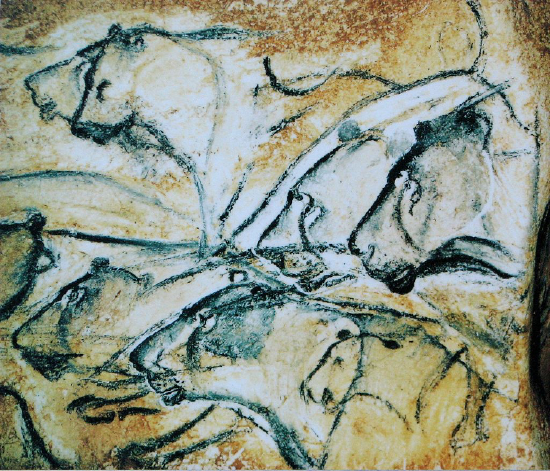
2.17 Painting of lions
The Chauvet Cave is not the only cave in the world with drawings of animals, nor is it the most unique. The discovery of caves is a difficult task due to the passage of time, rock slides, or vegetation growth that block the entrances from current exploration. The cave is sealed off from encroachment of humans, preventing artwork on the walls and the artifacts from the indigenous people from being destryoed. Many caves have artifacts from the animals that lived in the caves that included their sleeping beds, impressed on the cave floor.
Lascaux – France: Archeologists have been discovering prehistoric caves over the last few centuries; however, some are found entirely by accident. In 1940, a tree fell, leaving a significant deep depression in the ground. Three boys and dog were out for a hike and discovered the hole when their dog fell into the cave. The three boys scampered in after their dog and stepped back 17,000 years in time. The boys and their dog continued to play in the cave for two years before they reported their discovery to an archeologist. The Lascaux Cave in France became an instant tourist attraction and was considered the most significant discovery of cave art to date.

2.18 Wild Horse
The Lascaux Cave is similar to the Chauvet Cave geologically, and the painted animals (2.18) are similar. The Lascaux Caves discovered much earlier, allowed people to enter the unprotected cave. Now they are sealed off to tourists since just breathing can damage the art. A team of artists and engineers used laser photography to map the entire Lascaux Cave, and with a computer-aided program, they built a reproduction site that looks, smells, and sounds just like the original cave. The cave is a large reproduction of the Great Hall of the Bulls and allows people to continually discover the beauty of cave art without the destruction of the original cave.
El Castillo – Spain: Several caves in Spain, including the El Castillo Cave (2.19), were explored to determine if sound or music had a part of the painting ritual in the caves. The research group went into the caves and used items the indigenous people accessed and created music by playing the stalactites. Different stalactites yielded distinctive sounds depending on the size, width, and length of the rock formation. They blew through horns from animals to produce loud bass sounds. The research thoroughly established the concept that indigenous people could and would have produced music, just as they made art.
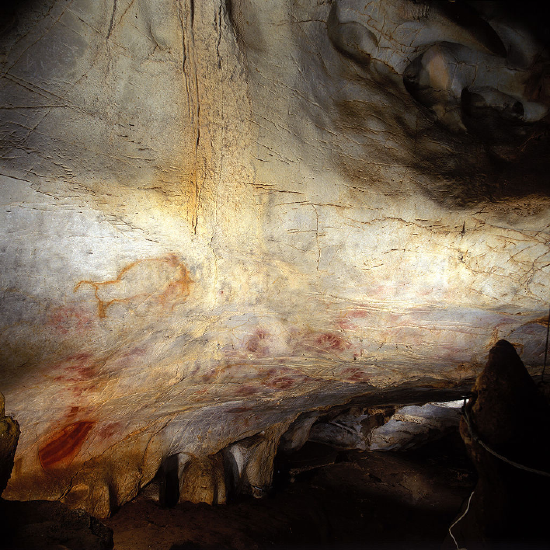
2.19 Main room El Castillo
One of the paintings was dated to 40,000 BCE and is a primitive red stippled disk. The cave yields many handprints, and a study of the finger length ratios led scientists to consider the stenciled handprints are primarily from women’s hands, challenging the belief that only men created cave art.
Oceania Caves
Nawarla Gabarnmang Rock Shelf – Australia: The Aboriginal people are indigenous to the continent of Australia and surrounding islands, descendants of those who migrated out of Africa over 125,000 years, and survived and thrived in peaceful coexistence with the harsh, drylands. They were nomadic tribes moving as needed to hunt and trade, an indigenous people who created extensive murals on the rocks, a tribute to an artistic society.
The Nawarla Gabarnmang Shelter, located in Kakadu Park, Australia, is another example of detailed drawing, painting, and carving on rock surfaces. Carbon dating has shown human occupation of the cave around 43,000 BCE. The walls, ceilings, and columns of the Shelter show mural paintings of detailed images of crocodiles, wallabies, kangaroos, and humans. The artists discovered a mulberry ochre that they made into a paint stick, giving the art its reddish-purple color. The area contains several rock and cave formations, all filled with detailed artwork of the people. The person on the wall in one of the other caves (2.20) appears to be celebrating
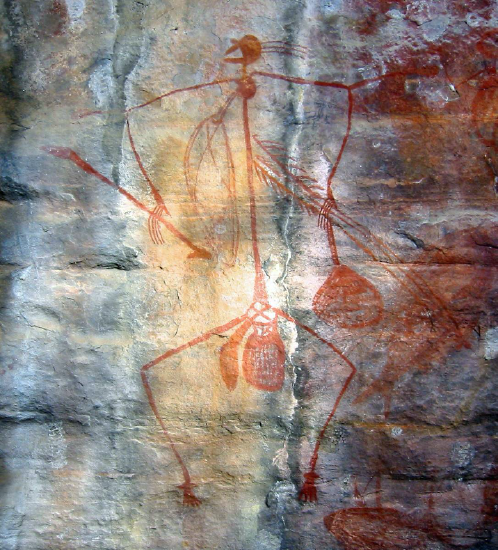
2.20 Cave painting
Sulawesi Cave – Indonesia: The Sulawesi Cave in Indonesia has many paintings by indigenous artists from 39,900 BCE, making them some of the oldest in the world. When recent people discovered the cave, they dismissed the age of the cave because they did not believe that art could survive the humid, tropical climate. A recent review of the art and modern analysis demonstrates the art is one of the oldest. The murals covered the ceilings at one time; however, today, only fragments (2.21) remain.
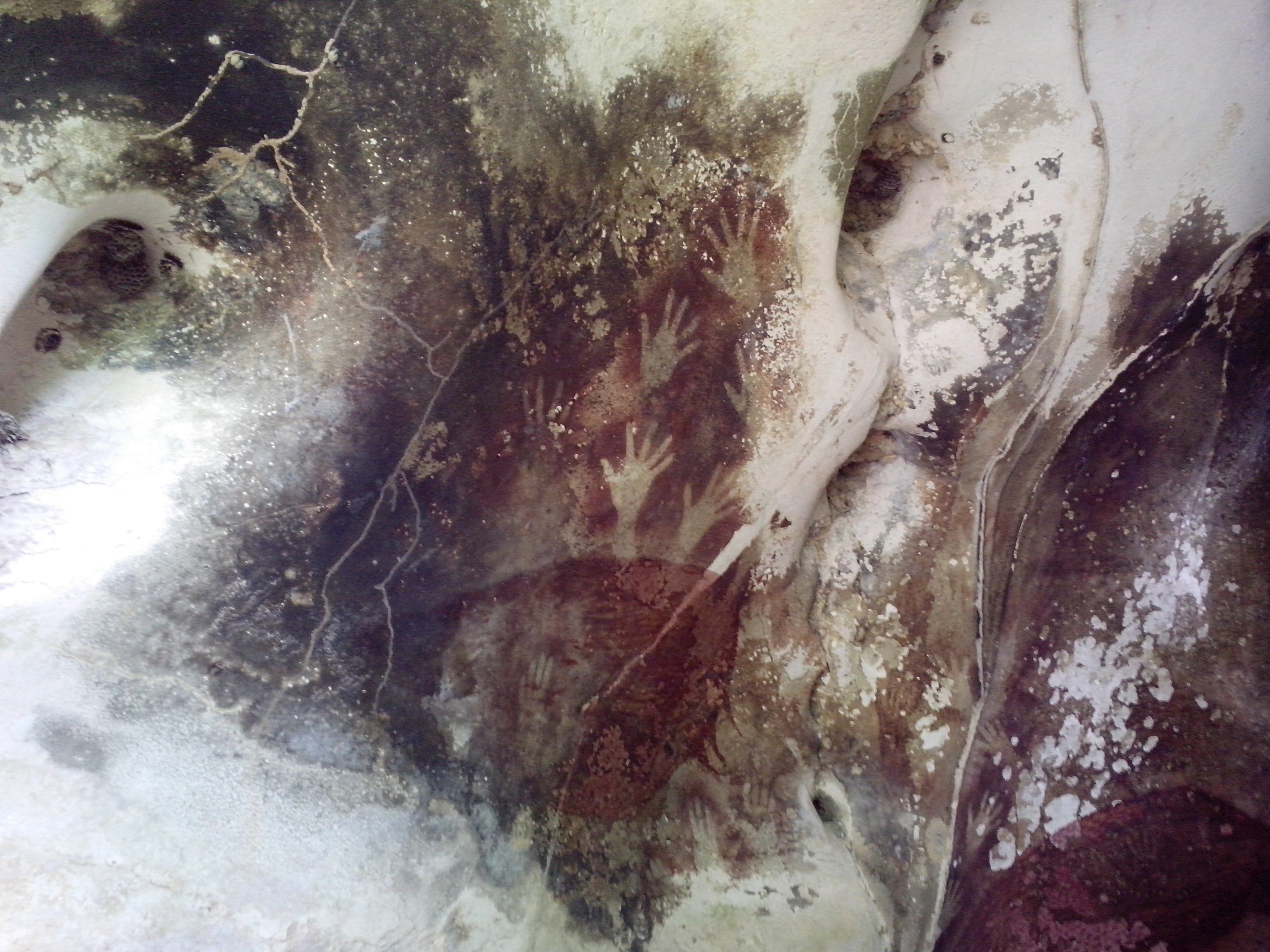
2.21 Handprint Sulawesi Cave (Cahyo Ramadhani, Wikimedia, CC BY-SA 3.0,
South American Caves
Cueva de las Manos – Argentina: Pattern can also refer to repetition, and in the Cueva de Las Manos cave in Argentina, the pattern of handprints (2.22) adorns the wall. The prints were made by people thousands of years ago when they sprayed pigment and water from their mouth over a hand held against the rock. The hand is pulled away, and the paint surrounds the hand giving the impression several people are waving their hands in the air. Most of the prints completed between 13,000 and 9500 BCE, showing depictions of animals and hunting scenes.
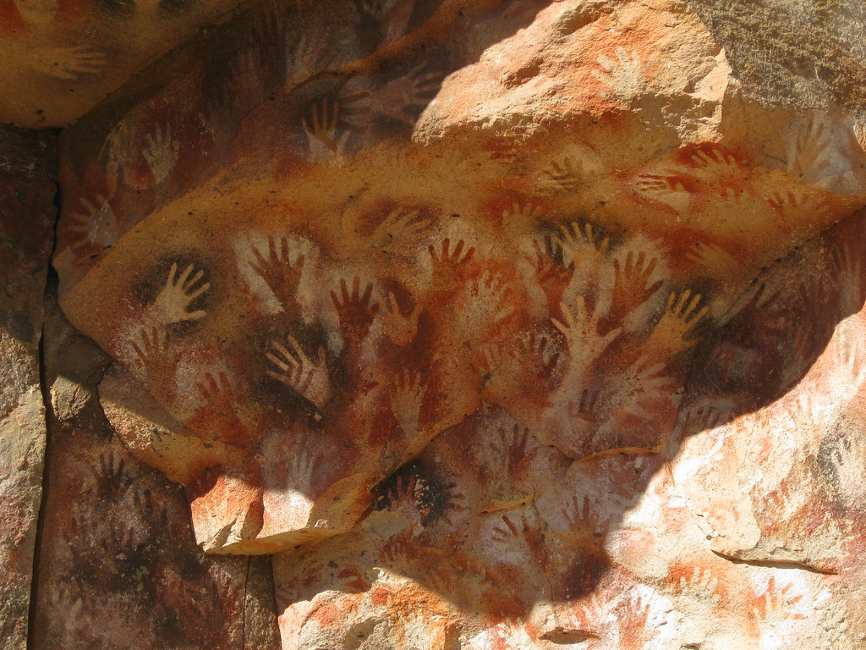
2.22 Handprints


